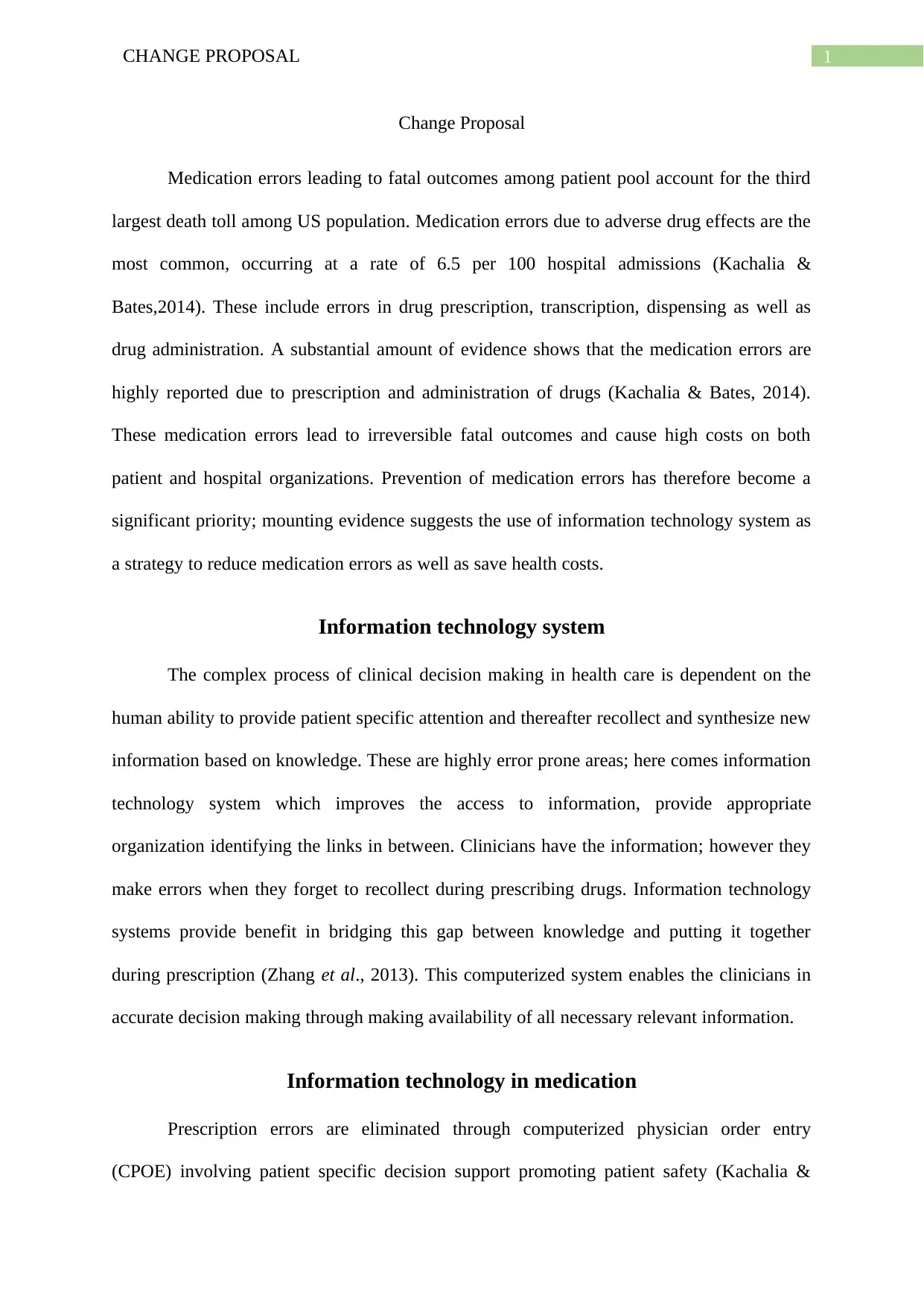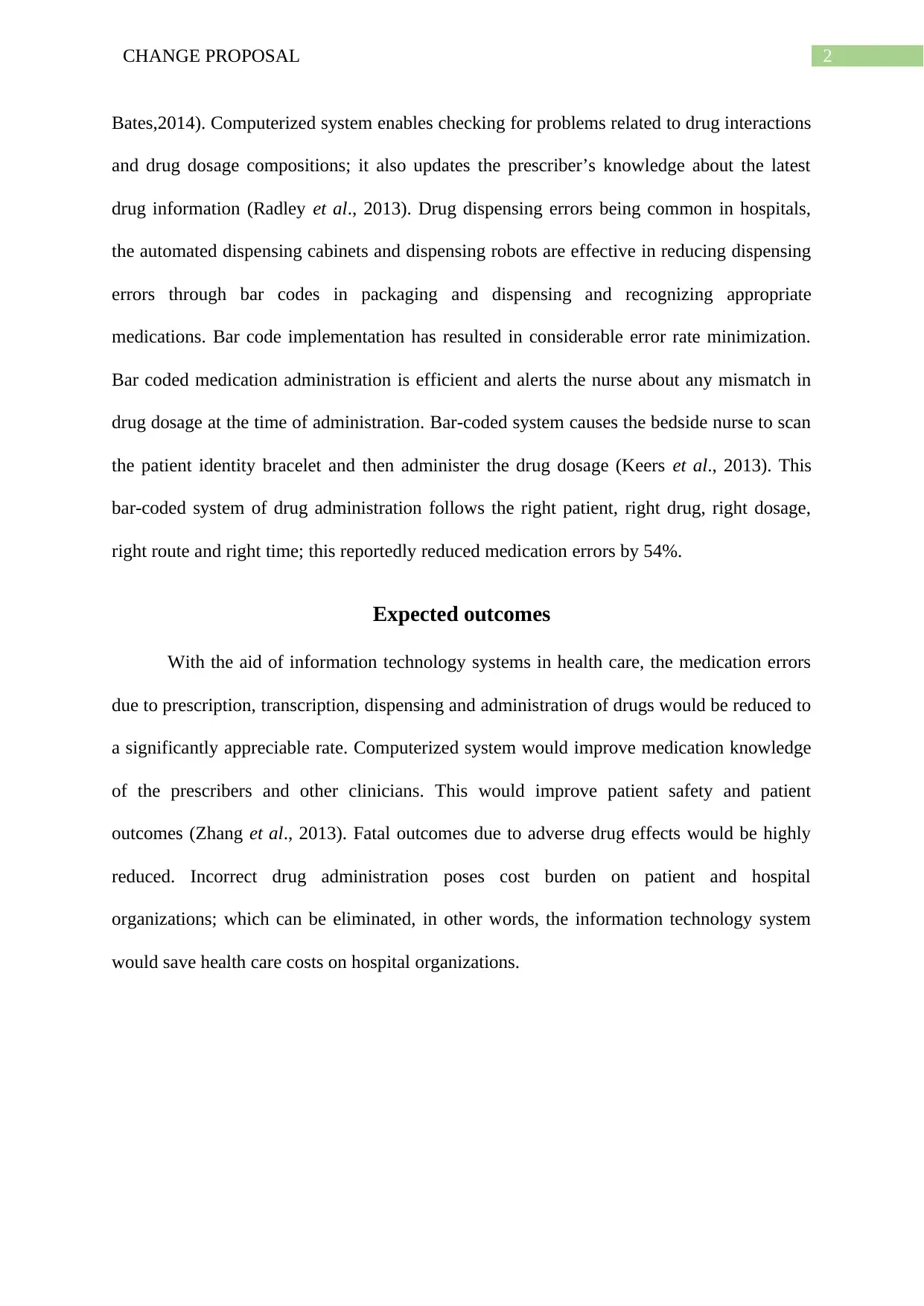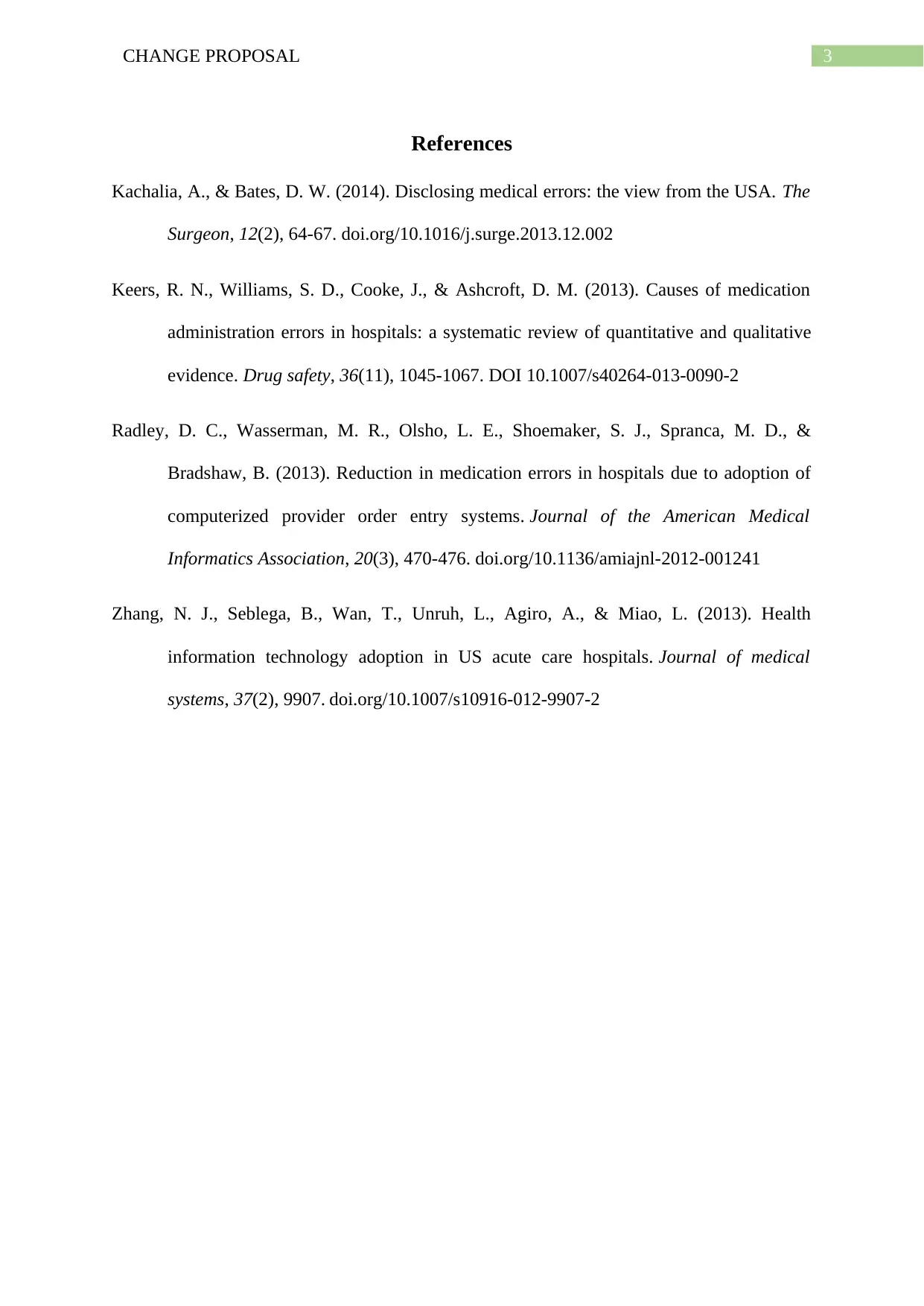Change Proposal
VerifiedAdded on 2023/04/21
|4
|800
|457
AI Summary
Medication errors leading to fatal outcomes among patient pool account for the third largest death toll among US population. Learn how information technology systems can help reduce medication errors and save healthcare costs.
Contribute Materials
Your contribution can guide someone’s learning journey. Share your
documents today.

Running head: CHANGE PROPOSAL
Ashley Ballesteros
1/21/2019
Grand Canyon University
Ashley Hartman
HLT-494-O101
Change Proposal
Ashley Ballesteros
1/21/2019
Grand Canyon University
Ashley Hartman
HLT-494-O101
Change Proposal
Secure Best Marks with AI Grader
Need help grading? Try our AI Grader for instant feedback on your assignments.

1CHANGE PROPOSAL
Change Proposal
Medication errors leading to fatal outcomes among patient pool account for the third
largest death toll among US population. Medication errors due to adverse drug effects are the
most common, occurring at a rate of 6.5 per 100 hospital admissions (Kachalia &
Bates,2014). These include errors in drug prescription, transcription, dispensing as well as
drug administration. A substantial amount of evidence shows that the medication errors are
highly reported due to prescription and administration of drugs (Kachalia & Bates, 2014).
These medication errors lead to irreversible fatal outcomes and cause high costs on both
patient and hospital organizations. Prevention of medication errors has therefore become a
significant priority; mounting evidence suggests the use of information technology system as
a strategy to reduce medication errors as well as save health costs.
Information technology system
The complex process of clinical decision making in health care is dependent on the
human ability to provide patient specific attention and thereafter recollect and synthesize new
information based on knowledge. These are highly error prone areas; here comes information
technology system which improves the access to information, provide appropriate
organization identifying the links in between. Clinicians have the information; however they
make errors when they forget to recollect during prescribing drugs. Information technology
systems provide benefit in bridging this gap between knowledge and putting it together
during prescription (Zhang et al., 2013). This computerized system enables the clinicians in
accurate decision making through making availability of all necessary relevant information.
Information technology in medication
Prescription errors are eliminated through computerized physician order entry
(CPOE) involving patient specific decision support promoting patient safety (Kachalia &
Change Proposal
Medication errors leading to fatal outcomes among patient pool account for the third
largest death toll among US population. Medication errors due to adverse drug effects are the
most common, occurring at a rate of 6.5 per 100 hospital admissions (Kachalia &
Bates,2014). These include errors in drug prescription, transcription, dispensing as well as
drug administration. A substantial amount of evidence shows that the medication errors are
highly reported due to prescription and administration of drugs (Kachalia & Bates, 2014).
These medication errors lead to irreversible fatal outcomes and cause high costs on both
patient and hospital organizations. Prevention of medication errors has therefore become a
significant priority; mounting evidence suggests the use of information technology system as
a strategy to reduce medication errors as well as save health costs.
Information technology system
The complex process of clinical decision making in health care is dependent on the
human ability to provide patient specific attention and thereafter recollect and synthesize new
information based on knowledge. These are highly error prone areas; here comes information
technology system which improves the access to information, provide appropriate
organization identifying the links in between. Clinicians have the information; however they
make errors when they forget to recollect during prescribing drugs. Information technology
systems provide benefit in bridging this gap between knowledge and putting it together
during prescription (Zhang et al., 2013). This computerized system enables the clinicians in
accurate decision making through making availability of all necessary relevant information.
Information technology in medication
Prescription errors are eliminated through computerized physician order entry
(CPOE) involving patient specific decision support promoting patient safety (Kachalia &

2CHANGE PROPOSAL
Bates,2014). Computerized system enables checking for problems related to drug interactions
and drug dosage compositions; it also updates the prescriber’s knowledge about the latest
drug information (Radley et al., 2013). Drug dispensing errors being common in hospitals,
the automated dispensing cabinets and dispensing robots are effective in reducing dispensing
errors through bar codes in packaging and dispensing and recognizing appropriate
medications. Bar code implementation has resulted in considerable error rate minimization.
Bar coded medication administration is efficient and alerts the nurse about any mismatch in
drug dosage at the time of administration. Bar-coded system causes the bedside nurse to scan
the patient identity bracelet and then administer the drug dosage (Keers et al., 2013). This
bar-coded system of drug administration follows the right patient, right drug, right dosage,
right route and right time; this reportedly reduced medication errors by 54%.
Expected outcomes
With the aid of information technology systems in health care, the medication errors
due to prescription, transcription, dispensing and administration of drugs would be reduced to
a significantly appreciable rate. Computerized system would improve medication knowledge
of the prescribers and other clinicians. This would improve patient safety and patient
outcomes (Zhang et al., 2013). Fatal outcomes due to adverse drug effects would be highly
reduced. Incorrect drug administration poses cost burden on patient and hospital
organizations; which can be eliminated, in other words, the information technology system
would save health care costs on hospital organizations.
Bates,2014). Computerized system enables checking for problems related to drug interactions
and drug dosage compositions; it also updates the prescriber’s knowledge about the latest
drug information (Radley et al., 2013). Drug dispensing errors being common in hospitals,
the automated dispensing cabinets and dispensing robots are effective in reducing dispensing
errors through bar codes in packaging and dispensing and recognizing appropriate
medications. Bar code implementation has resulted in considerable error rate minimization.
Bar coded medication administration is efficient and alerts the nurse about any mismatch in
drug dosage at the time of administration. Bar-coded system causes the bedside nurse to scan
the patient identity bracelet and then administer the drug dosage (Keers et al., 2013). This
bar-coded system of drug administration follows the right patient, right drug, right dosage,
right route and right time; this reportedly reduced medication errors by 54%.
Expected outcomes
With the aid of information technology systems in health care, the medication errors
due to prescription, transcription, dispensing and administration of drugs would be reduced to
a significantly appreciable rate. Computerized system would improve medication knowledge
of the prescribers and other clinicians. This would improve patient safety and patient
outcomes (Zhang et al., 2013). Fatal outcomes due to adverse drug effects would be highly
reduced. Incorrect drug administration poses cost burden on patient and hospital
organizations; which can be eliminated, in other words, the information technology system
would save health care costs on hospital organizations.

3CHANGE PROPOSAL
References
Kachalia, A., & Bates, D. W. (2014). Disclosing medical errors: the view from the USA. The
Surgeon, 12(2), 64-67. doi.org/10.1016/j.surge.2013.12.002
Keers, R. N., Williams, S. D., Cooke, J., & Ashcroft, D. M. (2013). Causes of medication
administration errors in hospitals: a systematic review of quantitative and qualitative
evidence. Drug safety, 36(11), 1045-1067. DOI 10.1007/s40264-013-0090-2
Radley, D. C., Wasserman, M. R., Olsho, L. E., Shoemaker, S. J., Spranca, M. D., &
Bradshaw, B. (2013). Reduction in medication errors in hospitals due to adoption of
computerized provider order entry systems. Journal of the American Medical
Informatics Association, 20(3), 470-476. doi.org/10.1136/amiajnl-2012-001241
Zhang, N. J., Seblega, B., Wan, T., Unruh, L., Agiro, A., & Miao, L. (2013). Health
information technology adoption in US acute care hospitals. Journal of medical
systems, 37(2), 9907. doi.org/10.1007/s10916-012-9907-2
References
Kachalia, A., & Bates, D. W. (2014). Disclosing medical errors: the view from the USA. The
Surgeon, 12(2), 64-67. doi.org/10.1016/j.surge.2013.12.002
Keers, R. N., Williams, S. D., Cooke, J., & Ashcroft, D. M. (2013). Causes of medication
administration errors in hospitals: a systematic review of quantitative and qualitative
evidence. Drug safety, 36(11), 1045-1067. DOI 10.1007/s40264-013-0090-2
Radley, D. C., Wasserman, M. R., Olsho, L. E., Shoemaker, S. J., Spranca, M. D., &
Bradshaw, B. (2013). Reduction in medication errors in hospitals due to adoption of
computerized provider order entry systems. Journal of the American Medical
Informatics Association, 20(3), 470-476. doi.org/10.1136/amiajnl-2012-001241
Zhang, N. J., Seblega, B., Wan, T., Unruh, L., Agiro, A., & Miao, L. (2013). Health
information technology adoption in US acute care hospitals. Journal of medical
systems, 37(2), 9907. doi.org/10.1007/s10916-012-9907-2
1 out of 4
Related Documents
Your All-in-One AI-Powered Toolkit for Academic Success.
+13062052269
info@desklib.com
Available 24*7 on WhatsApp / Email
![[object Object]](/_next/static/media/star-bottom.7253800d.svg)
Unlock your academic potential
© 2024 | Zucol Services PVT LTD | All rights reserved.





